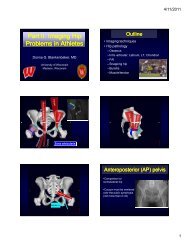Ankle and Foot 47 - Department of Radiology - University of ...
Ankle and Foot 47 - Department of Radiology - University of ...
Ankle and Foot 47 - Department of Radiology - University of ...
You also want an ePaper? Increase the reach of your titles
YUMPU automatically turns print PDFs into web optimized ePapers that Google loves.
2284 VII Imaging <strong>of</strong> the Musculoskeletal System<br />
Figure <strong>47</strong>-90. Subtle Lisfranc dislocation in a 56-<br />
year-old, nondiabetic patient who mis-stepped from<br />
a high curb <strong>and</strong> l<strong>and</strong>ed awkwardly, injuring the foot.<br />
A, Initial radiograph shows the fracture <strong>of</strong>f the base <strong>of</strong><br />
the second metatarsal (arrow). The alignment <strong>of</strong> the<br />
Lisfranc joint is relatively maintained. Because <strong>of</strong> the<br />
degree <strong>of</strong> s<strong>of</strong>t tissue swelling, the patient was initially<br />
treated with a boot. B, Axial CT scan obtained 5 days<br />
later showed the second metatarsal fracture to be<br />
essentially nondisplaced <strong>and</strong> the first <strong>and</strong> second<br />
tarsometatarsal joints to be in anatomic alignment.<br />
When the s<strong>of</strong>t tissue swelling subsided 4 days later,<br />
the boot was exchanged for a cast. C, Postcasting<br />
anteroposterior radiograph reveals that there is lateral<br />
displacement <strong>of</strong> the first (white arrow) <strong>and</strong> second<br />
(black arrow) metatarsals. Because this demonstrated<br />
that the Lisfranc joint was not stable, 3 days later the<br />
patient was taken to the operating room for open<br />
reduction <strong>and</strong> internal fixation (D).<br />
A<br />
B<br />
C<br />
D<br />
subcortical sclerosis, <strong>and</strong> subcortical round lucencies called<br />
geodes—are typically well seen radiographically. But some<br />
joints, such as the ankle <strong>and</strong> subtalar joints, can be difficult<br />
to pr<strong>of</strong>ile radiographically, <strong>and</strong> in such cases CT should be<br />
well able to demonstrate all these osteoarthritic changes<br />
(Fig. <strong>47</strong>-91).<br />
• Rheumatoid Arthritis<br />
For rheumatoid arthritis, we prefer MRI to CT when crosssectional<br />
imaging is required. MRI after the administration<br />
<strong>of</strong> intravenous contrast well demonstrates abnormally vas-<br />
cularized synovium <strong>and</strong> thickened pannus (see Fig. <strong>47</strong>-55)<br />
as well as small cortical erosions before they become radiographically<br />
apparent.<br />
• Gout<br />
Gout is uric acid crystal deposition arthropathy with a<br />
predilection for the foot, particularly the first metatarsophalangeal<br />
joint. The cortical erosions caused by gout form<br />
slowly <strong>and</strong> can take as long as a decade to be manifest<br />
radiographically. These erosions are classically described as<br />
being well circumscribed with sharp overhanging edges.<br />
The diagnosis <strong>of</strong> gout is confirmed when an aspirate <strong>of</strong><br />
Ch0<strong>47</strong>-A05375.indd 2284<br />
9/9/2008 5:35:35 PM
















